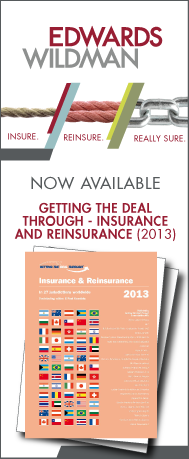 |
|
| edwardswildman.com | |
Solvency II: Why the UK's Prudential Regulation Authority Must Show More Humility by Chris Finney (London) By 19 April 2013, Andrew Tyrie, Chair of the UK’s Parliamentary Commission on Banking Standards and the UK Treasury Committee, had sent two letters to Andrew Bailey, a deputy governor of the Bank of England and CEO of the Prudential Regulatory Authority (PRA), and Bailey had sent two back. On 30 April 2013, Tyrie published both of Bailey’s letters, but only one of his own. Tyrie has not explained why he part-published, or why he published on 30 April. The ‘missing’ Tyrie letter was the first in a series, so it may have influenced the correspondence that followed. Perhaps it also explained why the chair of the Banking Standards Commission was interested in insurance regulation. In his replies, Bailey made four points.
This is the first time a senior UK regulator has publicly accepted that Solvency II has “ground to a halt”, and that it has done so for reasons of national interest, even though the Omnibus II trilogue ground to halt on 12 July 2012 for the same reasons. It is also the first time a senior UK regulator has publicly criticised other European countries. We have always known that Solvency II would be maximum harmonising, and that it would gradually lead to a single European approach to supervision, a single European insurance handbook and - in all probability - a single European regulator. That is part of the raison d’etre for the ‘Lamfalussy process’ (which is being used to ‘build’ Solvency II) and the European Insurance and Occupational Pensions Authority (a key contributor to the new regime, and an organisation that clearly sees itself as a single European regulator in waiting). The FSA accepted this reality, and worked hard to influence it. It is now clear that the PRA, like the Bank of England before it, sees Europe through the eyes of Henry VIII: it cannot quite accept European law as a ‘higher authority’, and it cannot tolerate fetters on its discretion. This is at least partly why the PRA is reluctant to include general guidance in its handbook, and to give individual guidance to firms. It is also why the Bank of England has never really understood why the UK has to make detailed rules to implement Solvency II, when the previous ‘governor’s eye-brow’ was always enough before1. Even so, the reference to “over-reliance on complex models”, and “models being used to pare capital requirements”, is well made. It is clear, from the Parliamentary Commission on Banking Standards’ Report into the Failure of HBOS, that Basel II – like Solvency II - relied too heavily on complex internal models; that these models were used (in part and by some) to pare capital requirements; and that Basel II implementation generated so much work that it distracted the banks and their regulators from more immediate and more material concerns. This must be a lesson well learned. What is less clear is what Bailey thinks the lesson is. His language suggests that his principal concern is that the number and complexity of internal model approval applications will overload supervisors; and that the “very detailed model approval requirements” will be inconsistent with the PRA’s judgment based approach to supervision. In an attempt to mitigate these risks, the PRA will use ‘early warning indicators’ – “simple measures which … alert supervisors to potential threats to solvency from models being used to pare capital requirements”. Whether these indicators will work remains to be seen. If they do, they can only be a partial answer to the risks Bailey has identified. After all, the PRA insists that its early warning indicators have been designed to make sure that internal models remain properly calibrated in a post-implementation Solvency II world. It is therefore hard to see how they will help mitigate the pre-implementation risks worrying Bailey today. Bailey’s comments about the early warning indicators are also interesting because this is the first time a senior UK regulator has accepted their potential illegality. (As Bailey points out, Solvency II is maximum harmonising. The UK cannot therefore require any more of its firms than Solvency II itself would require, if the UK’s additional requirements are in the “Solvency II-harmonised field”. And, at least at first blush, they are.) Bailey’s call for Parliament to “cast light on a process which has gone on for … ten years” is also rather curious because the FSA – the PRA’s immediate predecessor – was so heavily involved in the Solvency II negotiations that it must have known precisely what was happening and why, and could therefore have answered Bailey’s questions much more quickly and easily than anyone else. In his response, Tyrie explains that “The Committee takes your concerns very seriously and plans to examine them further in the coming months”. It will be interesting to see if this results in another critique of the FSA, whether it will be used to seek to persuade the European authorities that Solvency II should be switched from ‘maximum’ to ‘minimum harmonisation’ – so the UK can require even more of its firms - and whether it will eventually lead to the unpicking of some parts of Solvency II. The UK has a track record of ‘gold-plating’ in this way, so this would not be a surprise, although it would still be disappointing for two reasons. The FSA regarded the Solvency II Directive as a major UK success, and the best outcome that could reasonably be achieved in the circumstances, and in many respects, it was right. The FSA also gave a clear commitment that it would implement Solvency II without ‘gold-plating’. Perhaps this will be one more way in which the PRA will distance itself from the FSA in the near or medium term. One other point is rather striking: Tyrie chose to publish Bailey’s letters on 30 April. As a result, they were already the stuff of gossip and conjecture when the US/EU Insurance Symposium opened in Washington DC on 1 May. Their publication could therefore have had – and may have been intended to have - a material impact on the Symposium. If that was the intention, it failed. The European and US delegates read out their prepared statements without mentioning Bailey, his letters or his concerns. Even so, a different story played out in the margins. Some European delegates were clearly irritated by Bailey’s comments, and angered by their publication. Others described them as pre-cursor to another set of “UK special pleadings” and more likely to do harm than good. Since then Sharon Bowles MEP, chair of the ECON Committee of the European Parliament, and a former co-rapporteur for Solvency II, has publicly criticised Bailey for his ‘narky’2 and ‘unhelpful’ comments, before calling on the PRA to show “more humility” in future. We now wait to see how the Committee will examine the issues Bailey has raised (apparently at the Commission’s invitation), what conclusions it will reach, what recommendations it will make and what impact these things will have on the final shape of Solvency II (if any). Firms with a strong interest in these issues may wish to give evidence to the Committee, whether it calls for evidence, or not. In the meantime, the Bailey/Tyrie letters are here, here and here. My previous blogs about the trilogue negotiations on Omnibus II are here and here; and my most recent blog about the PRA’s early warning indicators is here.
ENDNOTES
1 According to folklore, in the good old days, the Bank of England did not regulate the banks using rules. The governor of the Bank of the England and the CEO of each bank met to discuss current issues. If the governor raised his eyebrow, the CEO knew he was displeased, and that was enough to solve that particular problem. 2 Critical and sarcastic. Contact
| |
 |
|

